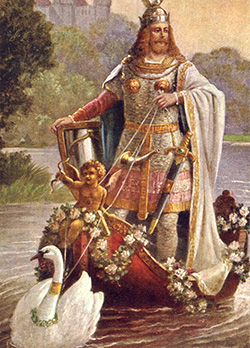 |
Opera in Three Acts |
 |
|
Synopsis |
ACT I: Antwerp, c. 900s. On the banks of the Scheldt, a Herald announces King Heinrich, who asks Count Telramund to explain why the Duchy of Brabant is torn by strife and disorder. Telramund accuses his young ward, Elsa, of having murdered her brother, Gottfried, heir to Brabant's Christian dynasty. (Gottfried was actually enchanted by the evil Ortrud, whom Telramund has wed.) When Elsa is called to defend herself, she relates a dream of a knight in shining armor who will come to save her. The herald calls for the defender, but only when Elsa prays does the knight appear, magically drawn in a boat by a swan. He betroths himself to her on condition that she never ask his name or origin. Defeating Telramund in combat, the newcomer establishes the innocence of his bride.
ACT II: Before dawn in the castle courtyard, Ortrud and the lamenting Telramund swear vengeance. When Elsa appears serenely in a window, Ortrud attempts to sow distrust in the girl's mind, preying on her curiosity, but Elsa innocently offers the scheming Ortrud friendship. Inside, while the victorious knight is proclaimed guardian of Brabant, the banned Telramund furtively enlists four noblemen to side with him against his newfound rival. At the cathedral entrance, Ortrud and Telramund attempt to stop the wedding - she by suggesting that the unknown knight is in fact an impostor, he by accusing Elsa's bridegroom of sorcery. The crowd stirs uneasily. Though troubled by doubt, Elsa reiterates her faith in the knight before they enter the church, accompanied by King Heinrich.
ACT III: Alone in the bridal chamber, Elsa and her husband express their love until anxiety and uncertainty at last compel the bride to ask the groom who he is and whence he has come. Before he can reply, Telramund and his henchmen burst in. With a cry, Elsa hands the knight his sword, with which he kills Telramund. Ordering the nobles to bear the body to the king, he sadly tells Elsa he will meet her later to answer her questions. |
